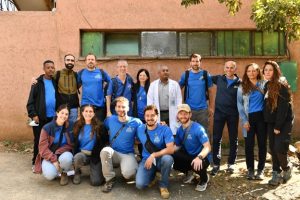
The Livestock sector is an important subsector of the nation’s economy and supports both the agricultural income and the Growth of Domestic Production. According to official report it contributes about 13 percent of the annual export earnings. Nevertheless, as Ethiopia has Un delimited long distance boarder with the neighboring countries, the large amount of unregistered cross border trade incurred heavy lose on the nation income.
Asfaw Negasa has been working in various none governmental international organization as livestalk researcher and consultant for the last three decades. As to him, despite the nation has untapped resources, the predominant traditional way of cattle rearing practice hampers the sector growth and to be remained stagnant.
At the house hold level, Livestock plays crucial economic and social role in the lives of pastoralists, agro-pastorals and supports small holder farmers in the high land parts of the country.
As the community is defined in a low income brackets ,the sector serves people to cope sever situation induced by climate change and global warming. Traditionally, pastoralists in the peripheral regions are not reached by banking system hence, animals used as accumulated capital and movable property.
In time of hard ship, they are exchanged in to money with less optimal price to purchase other vital goods which support their lively hood.
Asfaw further said that, in the small holder mixed farming system , animals provide nutritious food, emergency income enable to purchase farm inputs and gasoline for cooking.
Studies indicate that, the rise of income in urban areas due to economic growth, necessitates demand for nutritious food derived from Livestock such as meat and milk and this implies that, the sector has a potential to support the nation economy as well as cattle raisers.
Cognizant of these, the government convinced that, the Livestock sub sector plays substantial role in the ongoing efforts in poverty alleviation and support the economy. Often its policy in this regard is harmonious through broad based encouragement in terms of budget, regulation and institutional arrangement and marketing.
Years back the pastoral affairs was given very little attention in terms of institutional structure as the result, the sector remained backward.
Decade and half ago regions such as Beneshangul Gumuz,the Southern Nations,Nationalities and peoples regions, Oromya,Afar and Somali regions which have excessive number of pastoral population established Bureau at the regional level pertinent to the sector.
The support provided by the government to the sector among others improving veterinary services, promoting credit system , market facilities and strengthening the availability of forage.
The establishment of the Ethiopian Agricultural Transformation Agency and its engagement in advising and providing technical support helpful to modernize the sector can be mentioned as exemplary.
In line with this, the establishment of the National Animal Health Diagnostic and Investigation Center with various projects plays pivotal role in value addition.
However, according to the United Nations Food and Agriculture Organization, there are various hurdles which could be mentioned as a bottleneck negatively affected the sector. Both production and marketing still suffer from efficiency and effectiveness.
The average productivity of Livestock in the country is among the lowest in the world, the rate of the number of Livestock to herders is dwindling from time to time due to the scarcity of forage and the prevalent of endemic diseases. The mortality rate of the animals is also the highest in the continent.
Various sources agreed that, Ethiopia has the largest Livestock population in Africa and according to the 2018 Central Statistics Authority estimation, the sedentary private holdings were about 49 million head of cattle,25 million head of ship,22 million head of goats, and 38 million head of poultry.
But still the number of animals in the pastoral areas and that of in the highlands are not clearly identified. Some rough estimation indicates that, the pastoral areas account for about 20 percent of cattle,40 percent of sheep, and 40 percent goats in the country.
Based on these estimation, the national number of cattle population rose to 59 million cattle,35 million sheep and 31 million goats.
It is understood that, the Livestock subsector character and value depends of the herders culture, agro-ecological and regional variation.
Particularly the sector role in the rural economy dynamics much differ in pastoral system than in the sedentary farming of the highland parts.
These situation also indicates that, the Livestock mortality and profitability and future prospects as well.
According to Asfaw, at the national level, a large share about 63 percent of the nation cattle is in the 3 to 10 year age group and out of this, 36 percent are females and these categorization reflects that the cattle are more productive and valuable in the age group. He also said that, further disaggregation by age would have helped to better understanding of the market aspect of the sector and the purpose of keeping the animals.
The usage of cattle also differ one from other.
For example, households in the central high land parts use Livestock for plowing and transporting but pastorals do not have similar usage.
It is proved that, the sedentary farming practiced in the high land parts contribute up to 45 percent of the GDP and behind this contribution, there is the oxen labor but it is still get insignificant attention.
Unlike the modern farming, agriculture seldom uses tractors and combiners. It is human and animal labors which play crucial role in production activities.
The other point that should be mentioned with regard to geographic variation and its impact on Livestock is that, the share of female cattle to the economic contribution in the pastoral areas much higher than the sedentary farming areas.80 percent in Afar,70 percent in Gambela and 68 percent in Somali region because they are mainly the source of milk.
The Ethiopian Herald July 19, 2020
ABEBE WOLDE GIORGIS





